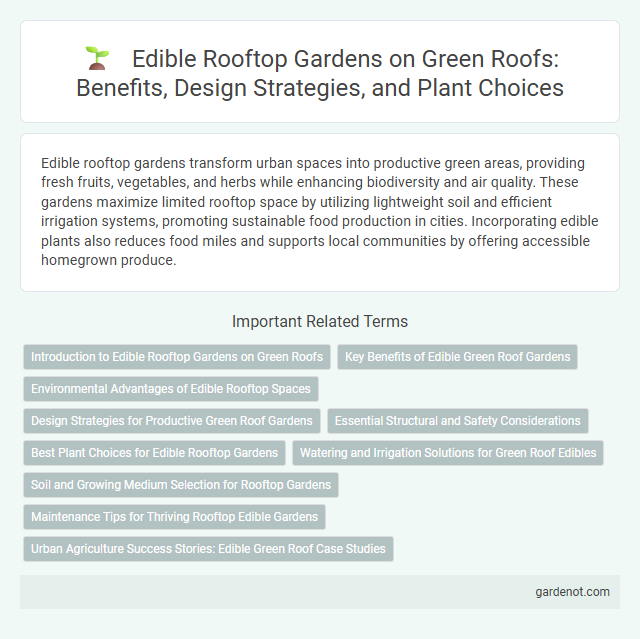Edible rooftop gardens transform urban spaces into productive green areas, providing fresh fruits, vegetables, and herbs while enhancing biodiversity and air quality. These gardens maximize limited rooftop space by utilizing lightweight soil and efficient irrigation systems, promoting sustainable food production in cities. Incorporating edible plants also reduces food miles and supports local communities by offering accessible homegrown produce.
Introduction to Edible Rooftop Gardens on Green Roofs
Edible rooftop gardens on green roofs transform urban spaces into productive environments by integrating fruit, vegetable, and herb cultivation with sustainable roofing systems. These gardens improve air quality, reduce urban heat islands, and promote local food production while enhancing biodiversity. Incorporating lightweight soil and efficient irrigation techniques ensures optimal plant growth and structural safety for rooftop installations.
Key Benefits of Edible Green Roof Gardens
Edible green roof gardens enhance urban sustainability by providing fresh, pesticide-free produce directly where it's consumed, reducing food miles and carbon footprints. These rooftop gardens improve building insulation, leading to energy savings on heating and cooling while managing stormwater runoff effectively. By increasing biodiversity and promoting local ecosystems, edible green roofs contribute to healthier urban environments and community well-being.
Environmental Advantages of Edible Rooftop Spaces
Edible rooftop gardens significantly improve urban air quality by absorbing carbon dioxide and producing oxygen while reducing the urban heat island effect through natural insulation. These green spaces promote biodiversity by providing habitats for pollinators such as bees and butterflies, enhancing local ecosystems. Water retention in rooftop gardens minimizes stormwater runoff, decreasing the burden on city drainage systems and reducing pollution in urban waterways.
Design Strategies for Productive Green Roof Gardens
Edible rooftop gardens maximize limited urban space by integrating lightweight soil substrates and drought-resistant crops for sustainable, productive green roofs. Strategic plant selection, including deep-rooted vegetables and herbs, enhances nutrient retention and water efficiency while promoting biodiversity. Incorporating modular raised beds and efficient irrigation systems further optimizes crop yield and maintenance on green roof structures.
Essential Structural and Safety Considerations
Essential structural and safety considerations for edible rooftop gardens include assessing load-bearing capacity to support soil, plants, and irrigation systems, typically requiring a minimum live load of 125 pounds per square foot. Waterproofing and root barrier installations are crucial to prevent water damage and root intrusion into the building envelope. Proper drainage systems and windbreaks mitigate water accumulation and plant displacement, ensuring both plant health and rooftop integrity.
Best Plant Choices for Edible Rooftop Gardens
Tomatoes, herbs like basil and mint, and leafy greens such as spinach and arugula thrive in edible rooftop gardens due to their adaptability to container growth and varying sunlight conditions. Strawberries and dwarf fruit trees maximize limited space while providing high yields in rooftop environments. Opting for drought-tolerant plants like lavender and chives ensures sustainability and reduces maintenance in rooftop garden settings.
Watering and Irrigation Solutions for Green Roof Edibles
Efficient watering and irrigation solutions for edible rooftop gardens are crucial to maintain healthy plant growth and optimize water usage. Drip irrigation systems and automated timers can provide precise moisture control, reducing water waste and preventing overwatering. Integrating rainwater harvesting with irrigation infrastructure enhances sustainability by utilizing natural resources for green roof edibles.
Soil and Growing Medium Selection for Rooftop Gardens
Selecting the right soil and growing medium for an edible rooftop garden is crucial to ensure adequate drainage, nutrient retention, and root support. Lightweight, well-aerated substrates rich in organic matter, such as a mix of compost, coconut coir, and perlite, enhance water retention without adding excessive weight to the roof structure. Proper pH balance between 6.0 and 7.0 and nutrient-rich soil composition optimize plant growth and yield in urban rooftop environments.
Maintenance Tips for Thriving Rooftop Edible Gardens
Maintaining a thriving edible rooftop garden requires consistent watering, using drip irrigation to ensure efficient moisture delivery. Regularly monitoring soil quality and adding organic compost enhances nutrient availability, promoting healthy plant growth. Pruning and pest control with natural remedies prevent disease while maximizing yield in limited rooftop spaces.
Urban Agriculture Success Stories: Edible Green Roof Case Studies
Edible rooftop gardens transform urban spaces into productive agricultural zones, significantly enhancing local food security and biodiversity. Case studies from cities like New York and Chicago showcase increased crop yields, reduced urban heat islands, and improved air quality through strategic planting of vegetables and herbs. These projects demonstrate scalable models for sustainable urban agriculture, integrating green infrastructure with community engagement.
Edible rooftop garden Infographic

 gardenot.com
gardenot.com